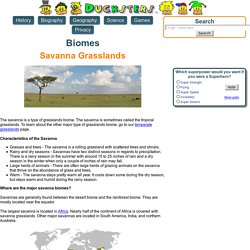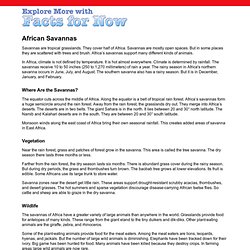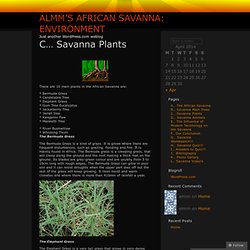

Interesting Facts. Savanna Fun Fact. Science for Kids: Savanna Grasslands Biome. The savanna is a type of grasslands biome.

The savanna is sometimes called the tropical grasslands. To learn about the other major type of grasslands biome, go to our temperate grasslands page. Characteristics of the Savanna Grasses and trees - The savanna is a rolling grassland with scattered trees and shrubs. Rainy and dry seasons - Savannas have two distinct seasons in regards to precipitation. Savannas are generally found between the desert biome and the rainforest biome. The largest savanna is located in Africa. Animals in the Savanna One of the more spectacular sights in nature is the animals of the African Savanna. The plant eating animals have developed ways at avoiding predators. At the same time predators of the savanna have adapted their own special skills.
One reason that so many different kinds of plant eating animals can live on the savanna is that different species have adapted to eat different plants. Facts for Now. Savannas are tropical grasslands.

They cover half of Africa. Savannas are mostly open spaces. But in some places they are scattered with trees and brush. Africa’s savannas support many different kinds of animals. In Africa, climate is not defined by temperature. Savanna - biome facts. Savanna Biome Facts. Climate. Savanna Getting Warmer. Rain in the Savanna. Savanna Climate. Precipitation Chart.
Biomes Savanna. Plants. Flowers. Savanna Explorer - Northern Australia - All Regions - Plants & Animals - Plants of the Savannas. The tropical savannas can impress with their sheer scale with mile after mile of uninterrupted grasslands or woodlands.

But if you stop to look more closely you will see diversity in the midst of this enormity. A roadside patch of woodland may contain a dozen different types of trees, various mid-storey shrubs, and a range of grasses. All these plants have adapted to the distinctive environment of Australia’s tropical savannas. For example, in most parts of the savanna plants have to be able to survive a long dry season with months of very little rainfall as a consequence savanna plants are usually very good at conserving moisture and many have become “deciduous” in that they shed their leaves during the dry season.
Most savanna plants also have to withstand regular bushfire and there is emerging evidence that the plants of northern Australia have been evolving in a fire-prone landscape for millions of years. Click on the topics in the left hand menu to find out more. Almm's African Savanna: Environment. There are 10 main plants in the African Savanna are: * Bermuda Grass * Candelabra Tree * Elephant Grass * Gum Tree Eucalyptus * Jackalberry Tree * Jarrah tree * Kangaroo Paw * Manketti Tree * River Bushwillow * Whistling ThornThe Bermuda Grass The Bermuda Grass is a kind of grass.

It is grows where there are frequent disturbances, such as grazing, flooding and fire. It is mainly found in Africa. The Elephant Grass The Elephant Grass is a very tall grass that grows in very dense clumps up to 3m tall. The Jarrah Tree The Jarrah tree is one of the main species of Eucalyptus. The Manketti Tree The Manketti tree has may names: Mongongo Nut and Featherweight Tree. Like this: Savanna Plants - The Great Savanna. Senegal Gum Acacia. Animals. Zebra. Birds. Griaffe. Rhino. Hippos.